The Most Relevant Socio-Economic Aspects of Medicinal and Aromatic Plants through a Literature Review
Abstract
1. Introduction
2. Materials and Methods
2.1. The Review Process
2.2. The Science Mapping
3. Results
3.1. The Quali–Quantitative Analysis of the Literature on MAPs
3.2. The Analysis of the Socio-Economic Literature on MAPs
3.3. The Focus on the Economic Documents
4. Discussions
5. Conclusions
Limitations of the Study
Author Contributions
Funding
Institutional Review Board Statement
Data Availability Statement
Conflicts of Interest
References
- Carrubba, A.; Marceddua, R.; Sarno, M. Bringing spontaneous plants to cultivation: Issues and constraints for medicinal and aromatic plants. Acta Hortic. 2023, 1358, 43–48. [Google Scholar] [CrossRef]
- Inoue, M.; Hayashi, S.; Craker, L.E. Role of medicinal and aromatic plants: Past, present, and future. In Pharmacognosy-Medicinal Plants; Perveen, S., Al-Taweel, A., Eds.; IntechOpen: London, UK, 2019; pp. 1–13. [Google Scholar]
- Azaizeh, H.; Saad, B.; Cooper, E.; Said, O. Traditional Arabic and Islamic Medicine, a Re-emerging Health Aid. Evid.-Based Complement. Altern. Med. 2010, 7, 419–424. [Google Scholar] [CrossRef] [PubMed]
- Stefanaki, A.; van Andel, T. Chapter 3—Mediterranean aromatic herbs and their culinary use. In Aromatic Herbs in Food—Bioactive Compounds, Processing, and Applications; Academic Press: Cambridge, MA, USA, 2021; pp. 93–121. [Google Scholar]
- Guleria, C.; Vaidya, M.K.; Sharma, R.; Dogra, D. Economics of Production and Marketing of important Medicinal and Aromatic Plants in Mid Hills of Himachal Pradesh. Econ. Aff. 2014, 59, 363–378. [Google Scholar] [CrossRef]
- Kipkosgei, D.K. Factors Influencing Sustainability of Medicinal Plants: A Case of Laikipia East District, Kenya. A Research Project Report Submitted in Partial Fulfillment for the Requirements of the Degree of Master of Arts in Project Planning and Management of the University of Nairobi. 2014. Available online: http://erepository.uonbi.ac.ke/bitstream/handle/11295/74125/Kipkosgei,Daniel?sequence=3 (accessed on 12 December 2023).
- Güney, O.I. Consumption attributes and preferences on medicinal and aromatic plants: A consumer segmentation analysis. Ciência Rural. 2019, 49, 5. [Google Scholar] [CrossRef]
- Marshall, E. Health and Wealth from Medicinal Aromatic Plants; FAO Diversification booklet number 17; Rural Infrastructure and Agro-Industries Division Food and Agriculture Organization of the United Nations: Rome, Italy, 2012; Available online: https://www.fao.org/3/i2473e/i2473e.pdf (accessed on 10 September 2023).
- Artukoğlu, M.; Usman, A.; Olgun, A. An evaluation of medicinal and aromatic plant trade in the world, in the EU and in Turkey. Agro Food Ind. Hi-Tech 2002, 13, 19–22. [Google Scholar]
- Varghese, R.; Ray, J.G. Sustainable agriculture of tropical spices: Arbuscular mycorrhizal fungi as an ecotechnological tool—A critical review. J. Appl. Res. Med. Aromat. Plants 2023, 36, 100507. [Google Scholar] [CrossRef]
- Ozdal, T.; Tomas, M.; Toydemir, G.; Kamiloglu, S.; Capanoglu, E. Chapter 1—Introduction to nutraceuticals, medicinal foods, and herbs. In Aromatic Herbs in Food—Bioactive Compounds, Processing, and Applications; Academic Press: Cambridge, MA, USA, 2021; pp. 1–34. [Google Scholar] [CrossRef]
- De Falco, E.; Rigano, D.; Fico, V.; Vitti, A.; Barile, G.; Pergola, M. Spontaneous Officinal Plants in the Cilento, Vallo di Diano and Alburni National Park: Tradition, Protection, Enhancement, and Recovery. Plants 2023, 12, 465. [Google Scholar] [CrossRef] [PubMed]
- Yadav, S.; Tiwari, K.S.; Gupta, C.; Tiwari, M.K.; Khan, A.; Sonkar, S.P. A brief review on natural dyes, pigments: Recent advances and future perspectives. Results Chem. 2023, 5, 100733. [Google Scholar] [CrossRef]
- Kuralkar, P.; Kuralkar, S.V. Role of herbal products in animal production—An updated review. J. Ethnopharmacol. 2021, 278, 114246. [Google Scholar] [CrossRef]
- Mayer, M.; Vogl, C.R.; Amorena, M.; Hamburger, M.; Walkenhorst, M. Treatment of organic livestock with medicinal plants: A systematic review of European ethnoveterinary research. Forsch. Komplementärmedizin 2014, 21, 375–386. [Google Scholar] [CrossRef]
- Jayakumar, S.; Baskaran, N.; Arumugam, R.; Sathiskumar, S.; Pugazhenthi, M. Herbal medicine as a live practice for treating livestock ailments by indigenous people: A case study from the Konar community of Tamil Nadu. S. Afr. J. Bot. 2018, 118, 23–32. [Google Scholar] [CrossRef]
- Akhila, A.; Tyagi, B.R.; Naqvi, A. Variation of essential oil constituents in C. martinii Wats var. motia at different stages of plant growth. Indian Perfum. 1987, 28, 126–128. [Google Scholar]
- Amri, I.; Hanana, M.; Jamoussi, B.; Hamrouni, L. Essential oils of Pinus nigra J.F. Arnold subsp. laricio Maire: Chemical composition and study of their herbicidal potential. Arab. J. Chem. 2017, 10, S3877–S3882. [Google Scholar] [CrossRef]
- Chen, Y.; Zhang, L.L.; Wang, W.; Wang, G. Recent updates on bioactive properties of α-terpineol. J. Essent. Oil Res. 2023, 35, 274–288. [Google Scholar] [CrossRef]
- Hogg, C.L.; Svoboda, K.P.; Hampson, J.B.; Brocklehurst, S. Investigation into the composition and bioactivity of essential oil from lovage (Levisticum officinale W.D.J. Koch). Int. J. Aromather. 2001, 11, 144–151. [Google Scholar] [CrossRef]
- Manion, C.R.; Widder, R.M. Essentials of essential oils. Am. J. Health-Syst. Pharm. 2017, 74, 153–162. [Google Scholar] [CrossRef]
- Reyes-Jurado, F.; Franco-Vega, A.; Ramírez-Corona, N.; Palou, E.; López-Malo, A. Essential Oils: Antimicrobial Activities, Extraction Methods, and Their Modeling. Food Eng. Rev. 2015, 7, 275–297. [Google Scholar] [CrossRef]
- Rodrigues, N.; Malheiro, R.; Casal, S.; Asensio-S-Manzanera, M.C.; Bento, A.; Pereira, J.A. Influence of spike lavender (Lavandula latifolia Med.) essential oil in the quality, stability, and composition of soybean oil during microwave heating. Food Chem. Toxicol. 2012, 50, 2894–2901. [Google Scholar] [CrossRef]
- Schilcher, H. Effects and Side-Effects of Essential Oils. In Essential Oils and Aromatic Plants; Svendsen, A.B., Scheffer, J.J.C., Eds.; Springer: Dordrecht, The Netherlands, 1985. [Google Scholar] [CrossRef]
- De Falco, E.; Roscigno, G.; Iodice, C.; Senatore, F. Phytomorphological and Essential Oil Characterization “In Situ” and “Ex Situ” of Wild Biotypes of Oregano Collected in the Campania Region (Southern Italy). Chem. Biodivers. J. 2013, 19, 2078–2090. [Google Scholar] [CrossRef]
- Gonçalves, S.; Romano, A. In vitro culture of lavenders (Lavandula spp.) and the production of secondary metabolites. Biotechnol. Adv. 2013, 31, 166–174. [Google Scholar] [CrossRef]
- Prusinowska, R.; Smigielski, K. Composition, biological properties, and therapeutic effects of lavender (Lavandula angustifolia L.). A review. Herba Pol. 2014, 60, 2. [Google Scholar] [CrossRef]
- Sabogal-Guáqueta, A.M.; Osorio, E.; Cardona-Gómez, G.P. Linalool reverses neuropathological and behavioral impairments in old triple transgenic Alzheimer’s mice. Neuropharmacology 2016, 102, 111–120. [Google Scholar] [CrossRef]
- Caputo, L.; Souza, L.F.; Alloisio, S.; Cornara, L.; De Feo, V. Coriandrum sativum and Lavandula angustifolia Essential Oils: Chemical Composition and Activity on Central Nervous System. Int. J. Mol. Sci. 2016, 17, 1999. [Google Scholar] [CrossRef] [PubMed]
- Nasiri, L.Z.; Hajimonfarednejad, M.; Riasaziano, M.; Abolhassanzadeh, Z.; Iraji, A.; Vojoud, M.; Heydari, M.; Shams, M.J. Efficacy of inhaled Lavandula angustifolia Mill. Essential oil on sleep quality, quality of life and metabolic control in patients with diabetes mellitus type II and insomnia. J. Ethnopharmacol. 2020, 251, 112560. [Google Scholar] [CrossRef] [PubMed]
- Tomou, E.M.; Lytra, K.; Chrysargyris, A.; Tzortzakis, N.; Skaltsa, H. NMR fingerprint comparison of cultivated Sideritis spp. from cyprus. Agronomy 2021, 11, 1503. [Google Scholar] [CrossRef]
- McKenna, M.; Miesner, U.; van Hal, J.; Ferro, G.; Onugha, I.; Varela, G.; Krishna, R.; Manghnani, R.; Rijal, S. Medicinal and Aromatic Plants Strategic Segmentation Analysis: Nepal; The World Bank: Washington, DC, USA, 2018; Available online: https://documents1.worldbank.org/curated/en/496421556737648658/pdf/Medicinal-and-Aromatic-Plants.pdf (accessed on 10 September 2023).
- Bicchi, C.; Joulain, D. Review headspace-gas chromatographic analysis of medicinal and aromatic plants and flowers. Flavour Fragr. J. 1990, 5, 131–145. [Google Scholar] [CrossRef]
- De Vincenzi, M.; Stammati, A.; De Vincenzi, A.; Silano, M. Constituents of aromatic plants: Carvacrol. Fitoterapia 2004, 75, 801–804. [Google Scholar] [CrossRef] [PubMed]
- Ertas, A.; Yigitkan, S.; Orhan, I.E. A Focused Review on Cognitive Improvement by the Genus salvia L. (Sage)—From Ethnopharmacology to Clinical Evidence. Pharmaceuticals 2023, 16, 171. [Google Scholar] [CrossRef]
- Joshi, B.R.; Hakim, M.M.; Patel, I.C. The biological active compounds and biological activities of Desmodium species from Indian region: A review. Beni-Suef Univ. J. Basic Appl. Sci. 2023, 12, 1. [Google Scholar] [CrossRef]
- Kdimy, A.; El Yadini, M.; Guaadaoui, A.; Bourais, I.; El Hajjaji, S.; Le, H.V. Phytochemistry, Biological Activities, Therapeutic Potential, and Socio-Economic Value of the Caper Bush (Capparis spinosa L.). Chem. Biodivers. 2022, 19, 202200300. [Google Scholar] [CrossRef]
- Lahlou, R.A.; Samba, N.; Soeiro, P.; Alves, G.; Gonçalves, A.C.; Silva, L.R.; Silvestre, S.; Rodilla, J.; Ismael, M.I. Thymus hirtus Willd. ssp. algeriensis Boiss. and Reut: A Comprehensive Review on Phytochemistry, Bioactivities, and Health-Enhancing Effects. Foods 2022, 11, 3195. [Google Scholar] [CrossRef]
- Luanda, A.; Ripanda, A.; Sahini, M.G.; Makangara, J.J. Ethnomedicinal uses, phytochemistry and pharmacological study of Ocimum americanum L.: A review. Phytomed 2023, 3, 100433. [Google Scholar] [CrossRef]
- Saqib, S.; Ullah, F.; Naeem, M.; Younas, M.; Ayaz, A.; Ali, S.; Zaman, W. Mentha: Nutritional and Health Attributes to Treat Various Ailments Including Cardiovascular Diseases. Molecules 2022, 27, 6728. [Google Scholar] [CrossRef] [PubMed]
- Teixeira Da Silva, J.A.; Yonekura, L.; Kaganda, J.; Mookdasanit, J.; Nhut, D.T.; Afach, G. Important secondary metabolites and essential oils of species within the Anthemideae (Asteraceae). J. Herbs Spices Med. Plants 2004, 11, 1–46. [Google Scholar] [CrossRef]
- Wilbert, W. The pneumatic theory of female Warao herbalists. Soc. Sci. Med. 1987, 25, 1139–1146. [Google Scholar] [CrossRef] [PubMed]
- Denyer, D.; Tranfield, D. Producing a systematic review. In The Sage Handbook of Organizational Research Methods; Buchanan, D.A., Bryman, A., Eds.; Sage Publications Ltd.: Thousand Oaks, CA, USA, 2009; pp. 671–689. [Google Scholar]
- Merli, R.; Preziosi, M.; Acampora, A. How do scholars approach the circular economy? A systematic literature review. J. Clean. Prod. 2018, 178, 703–722. [Google Scholar] [CrossRef]
- Mayring, P. Introduction to Qualitative Social Research (Einführung in Die Qualitative Sozialforschung); Henriette Swiatek: Berlin, Germany, 2002. [Google Scholar]
- Tranfield, D.C.; Denyer, D.C.; Smart, P. Towards a methodology for evidence-based management. Br. J. Manag. 2003, 14, 207–222. [Google Scholar] [CrossRef]
- Aghaei Chadegani, A.; Salehi, H.; Md Yunus, M.M.; Farhadi, H.; Fooladi, M.; Farhadi, M.; Ale Ebrahim, N. A comparison between two main academic literature collections: Web of science and Scopus databases. Asian Soc. Sci. 2013, 9, 18–26. [Google Scholar] [CrossRef]
- Guz, A.N.; Rushchitsky, J.J. Scopus: A system for the evaluation of scientific journals. Int. Appl. Mech. 2009, 45, 351–362. [Google Scholar] [CrossRef]
- Sánchez, A.D.; de la Cruz Del Río Rama, M.; García, J.Á. Bibliometric analysis of publications on wine tourism in the databases Scopus and WoS. Eur. Res. Manag. Bus. Econ. 2017, 23, 8–15. [Google Scholar] [CrossRef]
- Donthu, N.; Kumar, S.; Mukherjee, D.; Pandey, N.; Lim, W.M. How to conduct a bibliometric analysis: An overview and guidelines. J. Bus. Res. 2021, 133, 285–296. [Google Scholar] [CrossRef]
- van Eck, N.J.; Waltman, L. Manual for VOSviewer Version 1.6.20. 2023. Available online: https://www.vosviewer.com/documentation/Manual_VOSviewer_1.6.20.pdf (accessed on 23 February 2024).
- Muley, A.; Medithi, S. A Quantitative Literature Analysis of the Research on Holy Basil (Tulsi). J. Scientometr. Res. 2022, 11, 30–36. [Google Scholar] [CrossRef]
- Mascre, M. Matières odorantes et matières médicinales de la France d’Outre-Mer. Prod. Pharm. 1947, 2, 392–403. [Google Scholar]
- Chauhan, A.; Verma, R.S.; Padalia, R.C. Influence of biotic and abiotic factors on yield and quality of medicinal and aromatic plants. In Climate Change Effect on Crop Productivity; CRC Press, Taylor Francis Group: Boca Raton, FL, USA, 2014; pp. 251–278. [Google Scholar]
- Planting of aromatic and medicinal plants in 1950. Cas. Českého Lékárnictva 1950, 63, 203.
- Cultivation of medicinal and of aromatic plants in 1950, in Czechoslovakia. Zdr. Rev. Věstník Minist. Zdr. 1950, 25, 273.
- Pritzel, K. Medicinal and aromatic plants from the pharmaceutic and industrial viewpoint. Die Pharm. 1951, 6, 261. [Google Scholar]
- Heeger, E.F. History of medicinal and aromatic plant culture with particular consideration of development in Germany. Die Pharm. 1951, 6, 262–273. [Google Scholar]
- Toxopeus, H.J. Value of variety selection in cultivation of medicinal and aromatic plants. Pharm. Weekbl. 1952, 87, 631–636. [Google Scholar] [PubMed]
- Riaz, U.; Iqbal, S.; Sohail, M.I.; Samreen, T.; Ashraf, M.; Akmal, F.; Siddiqui, A.; Ahmad, I.; Naveed, M.; Naveed Iqbal, K.; et al. A Comprehensive Review on Emerging Importance and Economical Potential of Medicinal and Aromatic Plants (MAPs) in Current Scenario. Pak. J. Agric. Res. 2021, 34, 381–392. [Google Scholar] [CrossRef]
- Bakkali, F.; Averbeck, S.; Averbeck, D.; Idaomar, M. Biological effects of essential oils—A review. Food Chem. Toxicol. 2008, 46, 446–475. [Google Scholar] [CrossRef] [PubMed]
- Miliauskas, G.; Venskutonis, P.R.; van Beek, T.A. Screening of radical scavenging activity of some medicinal and aromatic plant extracts. Food Chem. 2004, 85, 231–237. [Google Scholar] [CrossRef]
- Kandaswami, C.; Lee, L.T.; Lee, P.P.; Hwang, J.J.; Ke, F.C.; Huang, Y.T.; Lee, M.T. The antitumor activities of flavonoids. In Vivo 2005, 19, 895–909. [Google Scholar]
- Zhou, H.; Beevers, C.S.; Huang, S. The targets of curcumin. Curr. Drug Targets 2011, 12, 332–347. [Google Scholar] [CrossRef]
- Sandur, S.K.; Pandey, M.K.; Sung, B.; Ahn, K.S.; Murakami, A.; Sethi, G.; Limtrakul, P.; Badmaev, V.; Aggarwal, B.B. Curcumin, demethoxycurcumin, bisdemethoxycurcumin, tetrahydrocurcumin and turmerones differentially regulate anti-inflammatory and anti-proliferative responses through a ROS-independent mechanism. Carcinogenesis 2007, 28, 1765–1773. [Google Scholar] [CrossRef]
- Lucchesi, M.E.; Chemat, F.; Smadja, J. Solvent-free microwave extraction of essential oil from aromatic herbs: Comparison with conventional hydro-distillation. J. Chromatogr. A 2004, 1043, 323–327. [Google Scholar] [CrossRef]
- Swamy, M.K.; Akhtar, M.S.; Sinniah, U.R. Antimicrobial Properties of Plant Essential Oils against Human Pathogens and Their Mode of Action: An Updated Review. Evid.-Based Complement. Altern. Med. 2016, 2016, 3012462. [Google Scholar] [CrossRef] [PubMed]
- Cimanga, K.; Kambu, K.; Tona, L.; Apers, S.; De Bruyne, T.; Hermans, N.; Totté, J.; Pieters, L.; Vlietinck, A.J. Correlation between chemical composition and antibacterial activity of essential oils of some aromatic medicinal plants growing in the Democratic Republic of Congo. J. Ethnopharmacol. 2002, 79, 213–220. [Google Scholar] [CrossRef] [PubMed]
- Sartoratto, A.; Machado, A.L.M.; Delarmelina, C.; Figueira, G.M.; Duarte, M.C.T.; Rehder, V.L.G. Composition and antimicrobial activity of essential oils from aromatic plants used in Brazil. Environmental and Soil Microbiology. Braz. J. Microbiol. 2004, 35, 275–280. [Google Scholar] [CrossRef]
- Cortés-Rojas, D.F.; de Souza, C.R.; Oliveira, W.P. Clove (Syzygium aromaticum): A precious spice. Asian Pac. J. Trop. Biomed. 2014, 4, 90–96. [Google Scholar] [CrossRef] [PubMed]
- Tucakov, J. Medicinal and aromatic plants of the sands of the Danube in Yugoslavia; economic importance and possibility of culturing them. Ann. Pharm. Fr. 1957, 15, 720–731. [Google Scholar] [PubMed]
- Verlet, N. Trends of the medicinal and aromatic plant sector in France. Acta Hortic. 1992, 306, 169–175. [Google Scholar] [CrossRef]
- Olsen, C.S.; Helles, F. Making the poorest poorer: Policies, laws and trade in medicinal plants in Nepal. J. World For. Resour. Manag. 1997, 8, 137–158. [Google Scholar]
- Olsen, C.S. The trade in medicinal and aromatic plants from central Nepal to Northern India. Econ. Bot. 1998, 52, 279–292. [Google Scholar] [CrossRef]
- Roersch, C. The marketing of medicinal, aromatic plants and essential oils in the Dominican Republic. Acta Hortic. 1999, 503, 197–219. [Google Scholar] [CrossRef]
- Craker, L.E. Trends in medicinal and aromatic plant production in the United States. Acta Hortic. 1999, 502, 71–75. [Google Scholar] [CrossRef]
- Bernáth, J. Biological and economical aspects of utilization and exploitation of wild growing medicinal plants in middle-and south Europe. Acta Hortic. 1999, 500, 31–41. [Google Scholar] [CrossRef]
- Hüsnü Can Başer, K. Industrial utilization of medicinal and aromatic plants. Acta Hortic. 1999, 503, 177–192. [Google Scholar] [CrossRef]
- Chandra, P.; Sharma, V.; Kant, S. From Commodity to Brand: The Country of Origin Branding Perspective for Indian Medicinal and Aromatic plants. Bus. Strategy Dev. 2019, 2, 4–12. [Google Scholar] [CrossRef]
- Fuentes Baluzzi, V.; Balsamo, M.; Galli, M.C.; Guariniello, J.; Jaldo Alvaro, M.; Risso, O.A.; Nagahama, N.; Mazzoni, A.O. Characterization of consumers of aromatic and medicinal plants in Argentina. Hortic. Argent. 2022, 41, 175–188. [Google Scholar]
- Ibishi, L.; Musliu, A. Impact of Medicinal and Aromatic Plants on improving the socio-economic situation of rural families in Kosovo. J. Agric. Environ. Int. Dev. 2021, 115, 39–50. [Google Scholar]
- Alaoui, H.I.; El Asri, B.; Ghazi, S.; Brhadda, N.; Ziri, R. Ethnobotanical and socio-economic evaluation of the medicinal and aromatic plants in the Oued beht watershed, Morocco. For. Ideas 2022, 28, 163–177. [Google Scholar]
- Goswami, K.; Thapa, D.B.; Sandilya, J.; Deka, N. An assessment of economic profitability of black rice (Oryza sativa L. indica) production in Assam, India. J. Appl. Res. Med. Aromat. Plants 2023, 34, 100488. [Google Scholar] [CrossRef]
- Pyakurel, D.; Subedee, B.R.; Subedi, C.K.; Gurung, J.; Chaudhary, R.P. Trade potentiality of oils extracted from Prunus davidiana (wild apricot), Sapindus mukorossi (soapnut) and Zanthoxylum armatum (Nepalese pepper) in Kailash Sacred Landscape, Nepal. Environ. Chall. 2022, 7, 100490. [Google Scholar] [CrossRef]
- Corrêa, J.R.C.; Scheffer, M.C. Experience in the integration of industry and growers in the production and marketing of medicinal plants. Acta Hortic. 1999, 503, 173–176. [Google Scholar] [CrossRef]
- Markovic, T.; Ivanovic, S.; Pajic, M. Costs and profit in chamomile production using weather put option. Custos Agronegocio 2014, 10, 285–295. [Google Scholar]
- Falk, C.L.; van Voorthuizen, H.; Wall, M.M.; Guldan, S.J.; Martin, C.A.; Kleitz, K.M. An Economic Analysis of Transplanting versus Direct Seeding of Selected Medicinal Herbs in New Mexico. J. Herbs Spices Med. Plants 2000, 7, 15–29. [Google Scholar] [CrossRef]
- Muyima, N.Y.O.; Zulu, G.; Bhengu, T.; Popplewell, D. The potential application of some novel essential oils as natural cosmetic preservatives in a aqueous cream formulation. Flavour Fragr. J. 2002, 17, 258–266. [Google Scholar] [CrossRef]
- Maroufi, K.; Farahani, H.A.; Darvishi, H.H. Importance of coriander (Coriandrum sativum L.) between the medicinal and aromatic plants. Adv. Environ. Biol. 2010, 4, 433–436. [Google Scholar]
- Choudhary, D.; Kala, S.P.; Todaria, N.P.; Rawat, R.B.S.; Kunwar, M.S.; Kollmair, M. Upgrading Mountain people in medicinal and aromatic plants value chains: Lessons for sustainable management and income generation from Uttarakhand, India. Int. J. Sustain. Dev. World Ecol. 2013, 20, 45–53. [Google Scholar] [CrossRef]
- Mehta, N.; Saini, R. Callistemon viminalis: A plant with industrial potential. Ann. Appl. Biol. 2016, 32, 127–133. [Google Scholar]
- Saraswatia, S.S.; Mastiholi, A.B.; Vandana, A.K.; Sakhubai, H.T. Economics of medicinal coleus (Plectranthus forskohlii Willd.). Acta Hortic. 2019, 1241, 91–94. [Google Scholar] [CrossRef]
- Bozdemir, Ç. Economic importance and usage fields of oregano species growing in Turkey. J. Agric. Sci. 2019, 29, 583–594. [Google Scholar]
- Kumar, D.; Kumar, R.R.; Singh, A.K.; Verma, K.; Singh, K.P.; Nilofer, S.; Kumar, A.; Singh, V.; Kaur, P.; Singh, A.; et al. A novel and economically viable agro-technique for enhancing productivity and resource use efficiency in menthol mint (Mentha arvensis L.). Ind. Crops Prod. 2019, 162, 113233. [Google Scholar] [CrossRef]
- Rymbai, H.; Das, A.; Mohapatra, K.P.; Talang, H.; Nongbri, B.; Law, I. Ginger (Zingiber officinale) based intercropping systems for enhancing productivity and income—A farmers’ participatory approach. Indian J. Agric. Sci. 2021, 91, 956–960. [Google Scholar] [CrossRef]
- Singh, A.; Verma, K.; Kumar, D.; Nilofer, S.; Lothe, N.B.; Kumar, A.; Chaudhary, A.; Kaur, P.; Singh, K.P.; Singh, A.K.; et al. Optimized irrigation regime and planting technique improve yields and economics in aloe vera [Aloe barbadensis (Miller)]. Ind. Crops Prod. 2021, 167, 113539. [Google Scholar] [CrossRef]
- Almansour, B.M.; Ali, G.A. Economic Analysis of Thyme (Origanum syriacum) Production for Smallholder Farmers. IOP Conf. Ser. Earth Environ. Sci. 2021, 923, 012001. [Google Scholar] [CrossRef]
- Pandey, A.K.; Kumar, P.; Saxena, M.J.; Maurya, P. Chapter 6—Distribution of aromatic plants in the world and their properties. In Feed Additives, Aromatic Plants and Herbs in Animal Nutrition and Health; Elsevier: Cambridge, MA, USA, 2020; pp. 89–114. [Google Scholar]
- Raina, R.; Gautam, K. Conservation and Utilization of High-Altitude Threatened Medicinal Plants. In Conservation and Utilization of Threatened Medicinal Plants; Springer: Berlin/Heidelberg, Germany, 2020; pp. 369–387. [Google Scholar]
- Karki, M.B. Harnessing the Potential of Medicinal, Aromatic and Non-timber Forest Products for Improving the Livelihoods of Pastoralists and Farmers in Himalayan Mountains. In Conservation and Utilization of Threatened Medicinal Plants; Springer: Berlin/Heidelberg, Germany, 2020; pp. 93–106. [Google Scholar]
- Corradini, G.; Vidale, E.; Pettenella, D. Certification standards applicable to Non-Wood Forest Products. In Forest Management Auditing: Certification of Forest Products and Services; Routledge: London, UK, 2018; pp. 147–161. [Google Scholar] [CrossRef]
- Rovira, M.; Garay, L.; Górriz-Mifsud, E.; Bonet, J.A. Territorial Marketing Based on Non-Wood Forest Products (NWFPs) to Enhance Sustainable Tourism in Rural Areas: A Literature Review. Forests 2022, 13, 1231. [Google Scholar] [CrossRef]
- Sher, H.; Barkworth, M.E. Economic development through medicinal and aromatic plants (MAPs) cultivation in Hindu Kush Himalaya mountains of District Swat, Pakistan. J. Mt. Sci. 2015, 12, 1292–1301. [Google Scholar] [CrossRef]
- Brinckmann, J.A.; Kathe, W.; Berkhoudt, K.; Harter, D.E.V.; Schippmann, U. A New Global Estimation of Medicinal and Aromatic Plant Species in Commercial Cultivation and Their Conservation Status. Econ. Bot. 2022, 76, 319–333. [Google Scholar] [CrossRef]

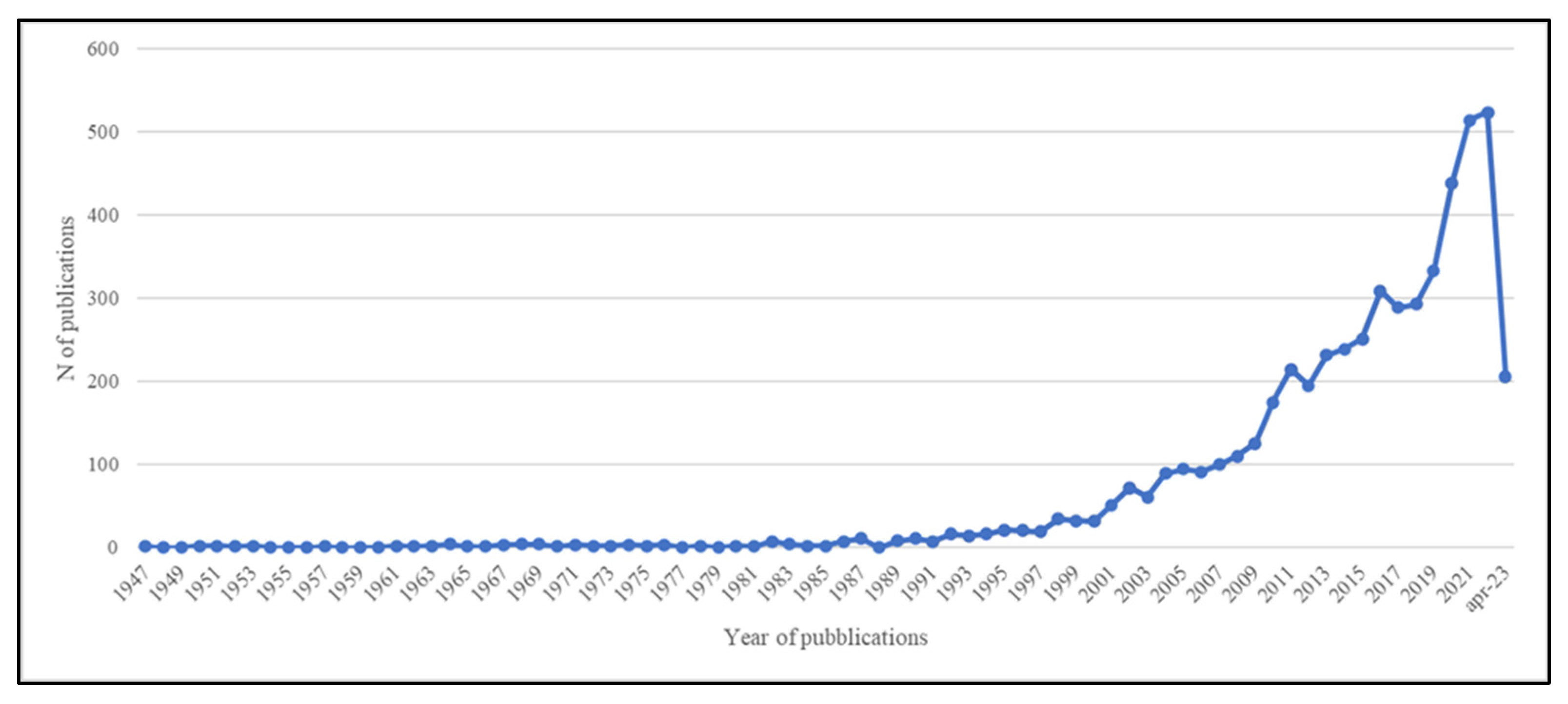

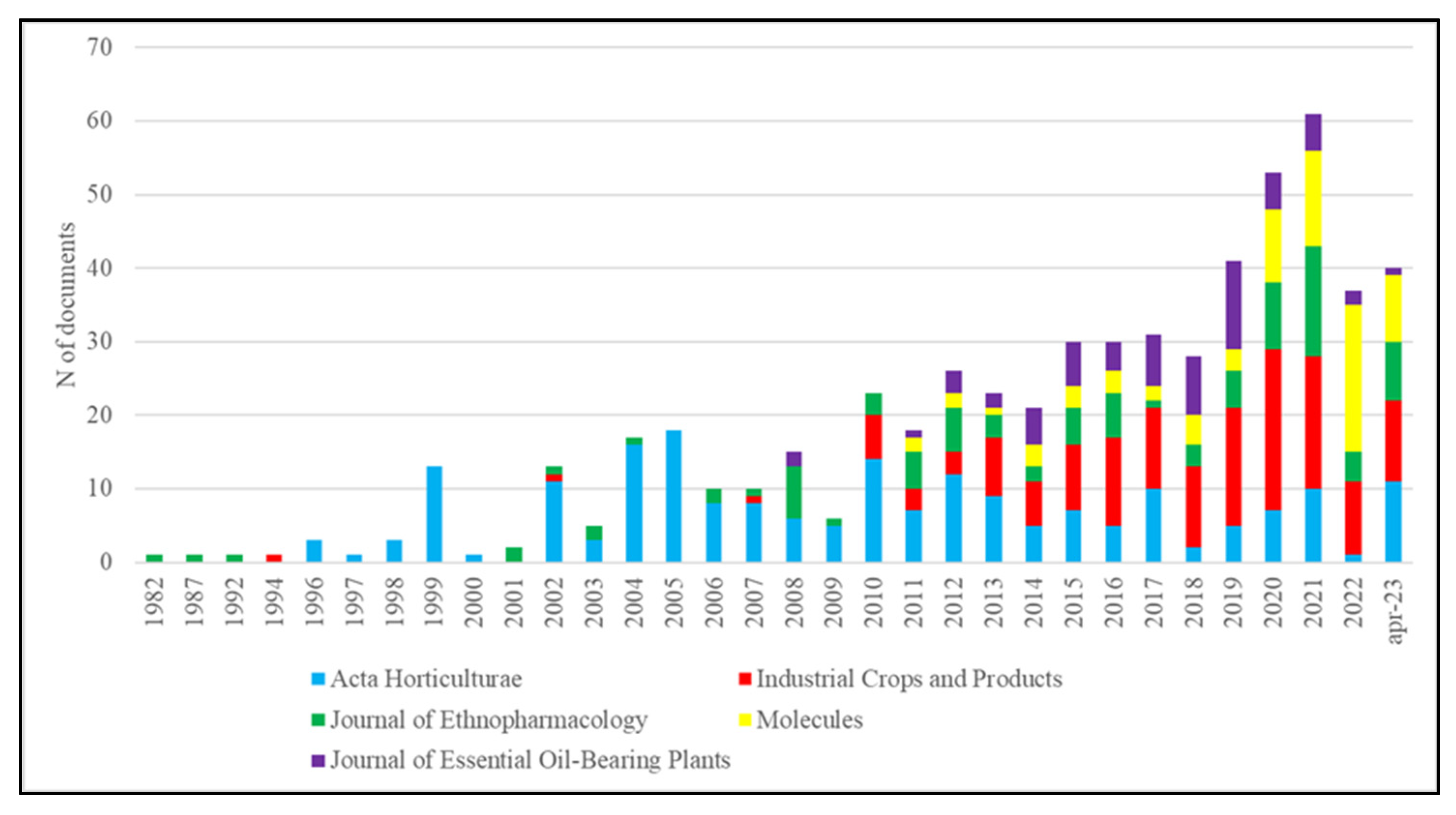
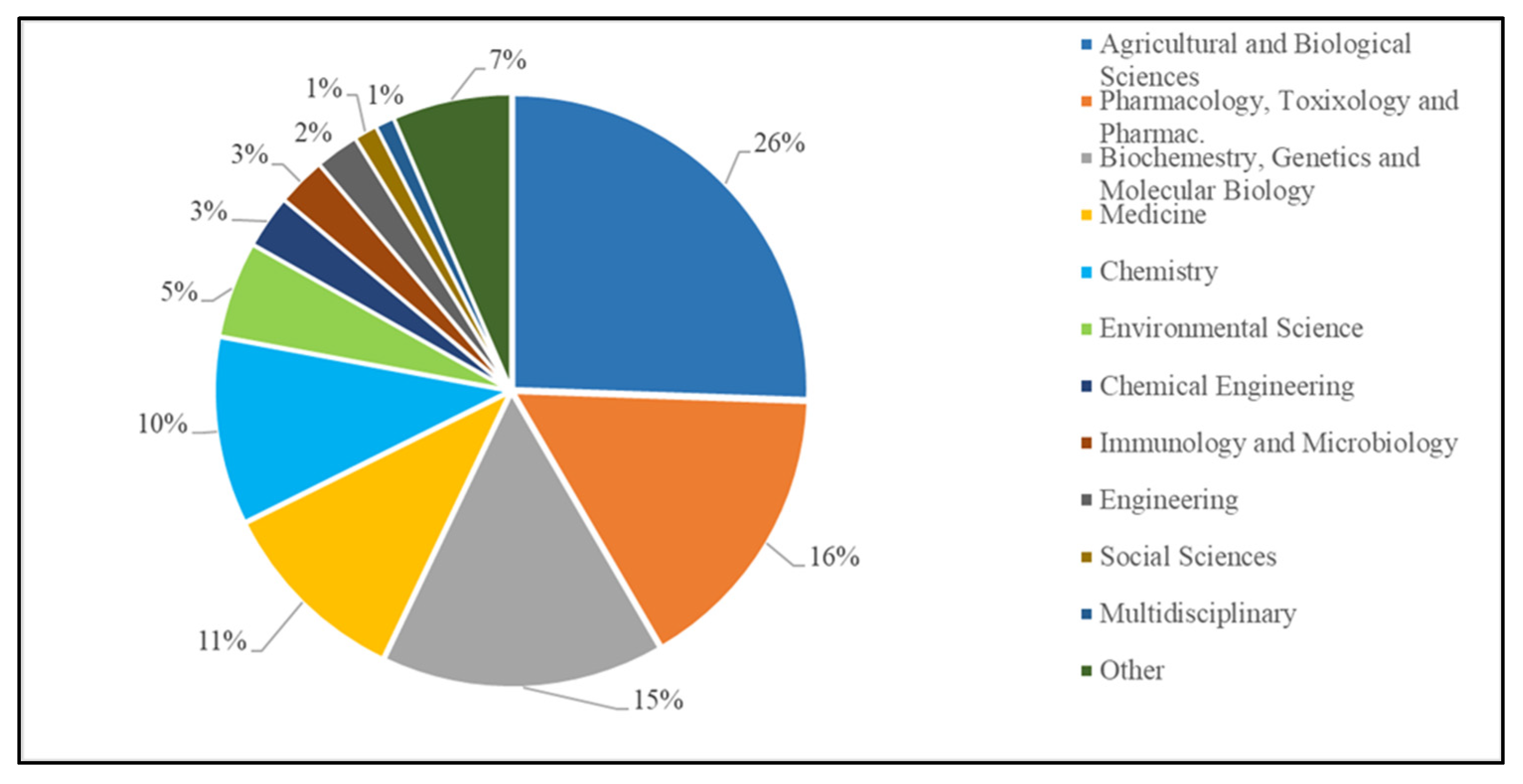
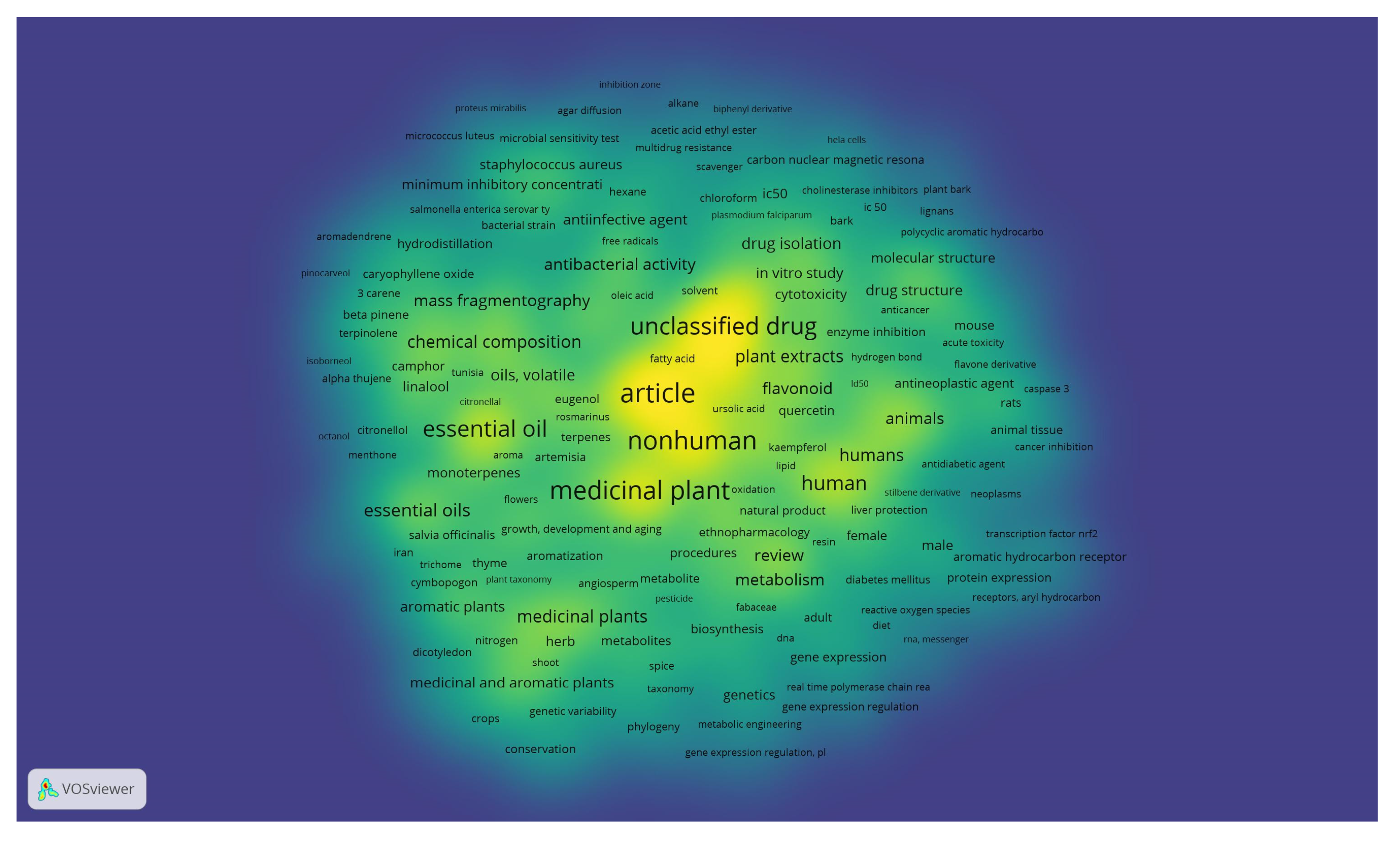
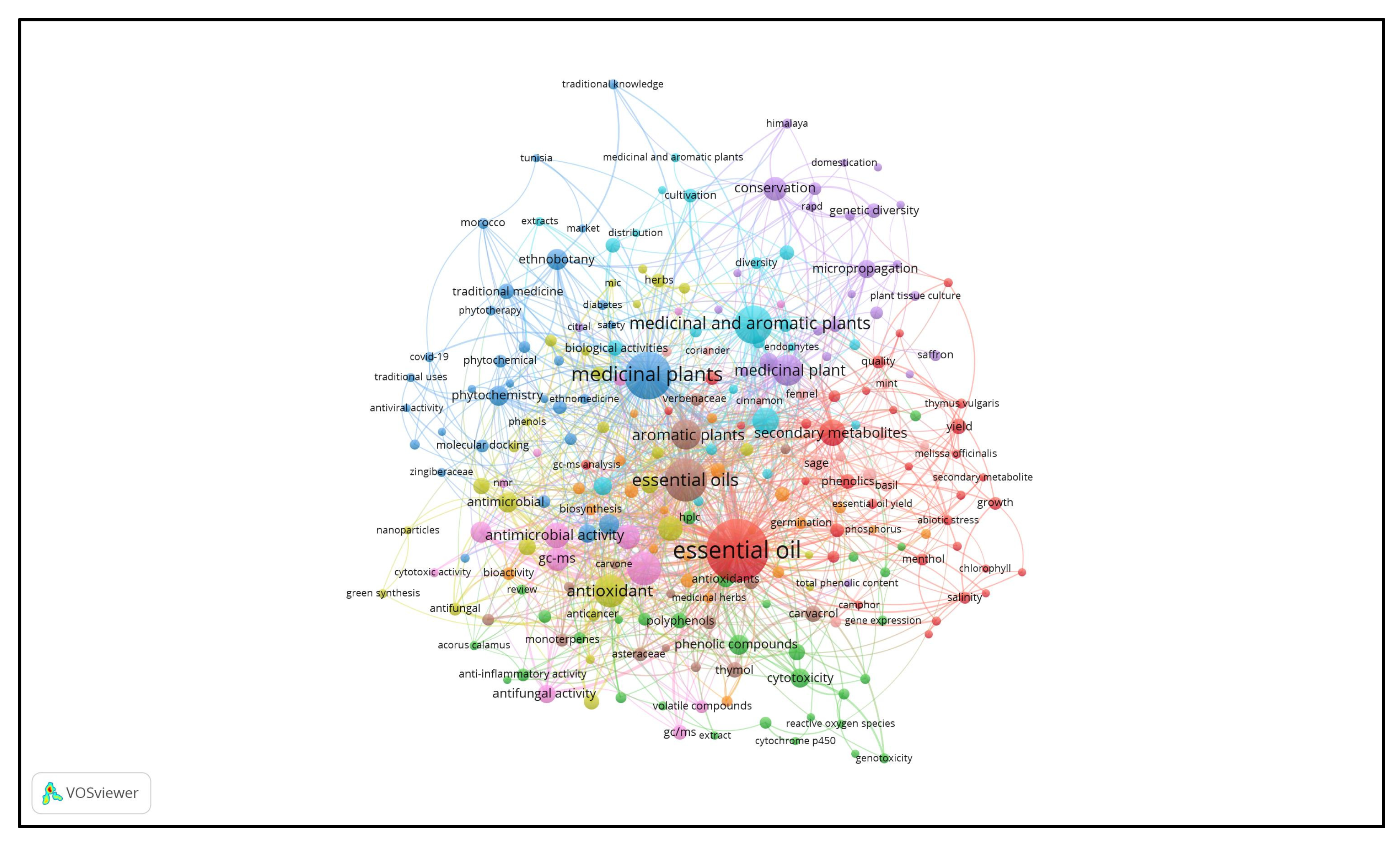

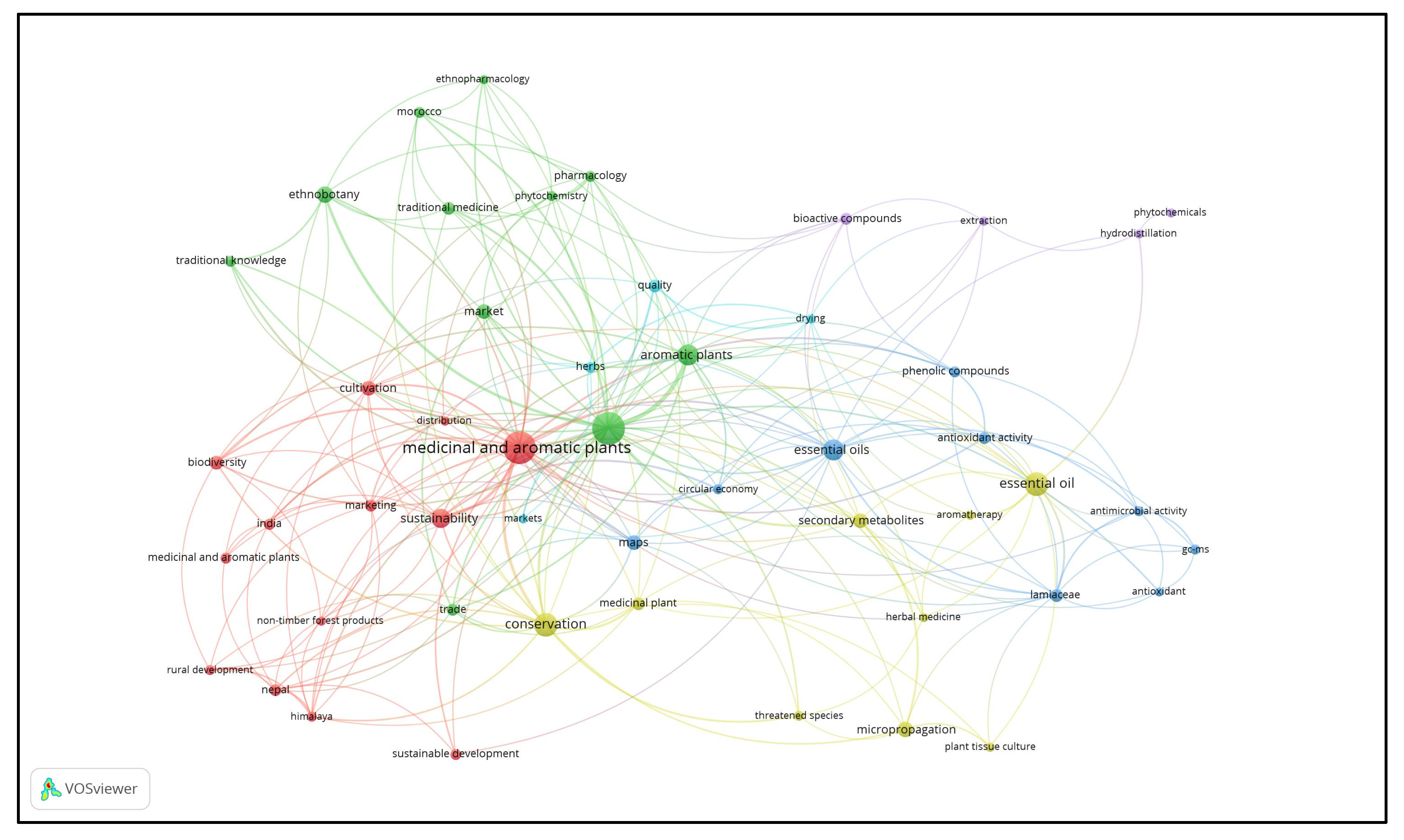
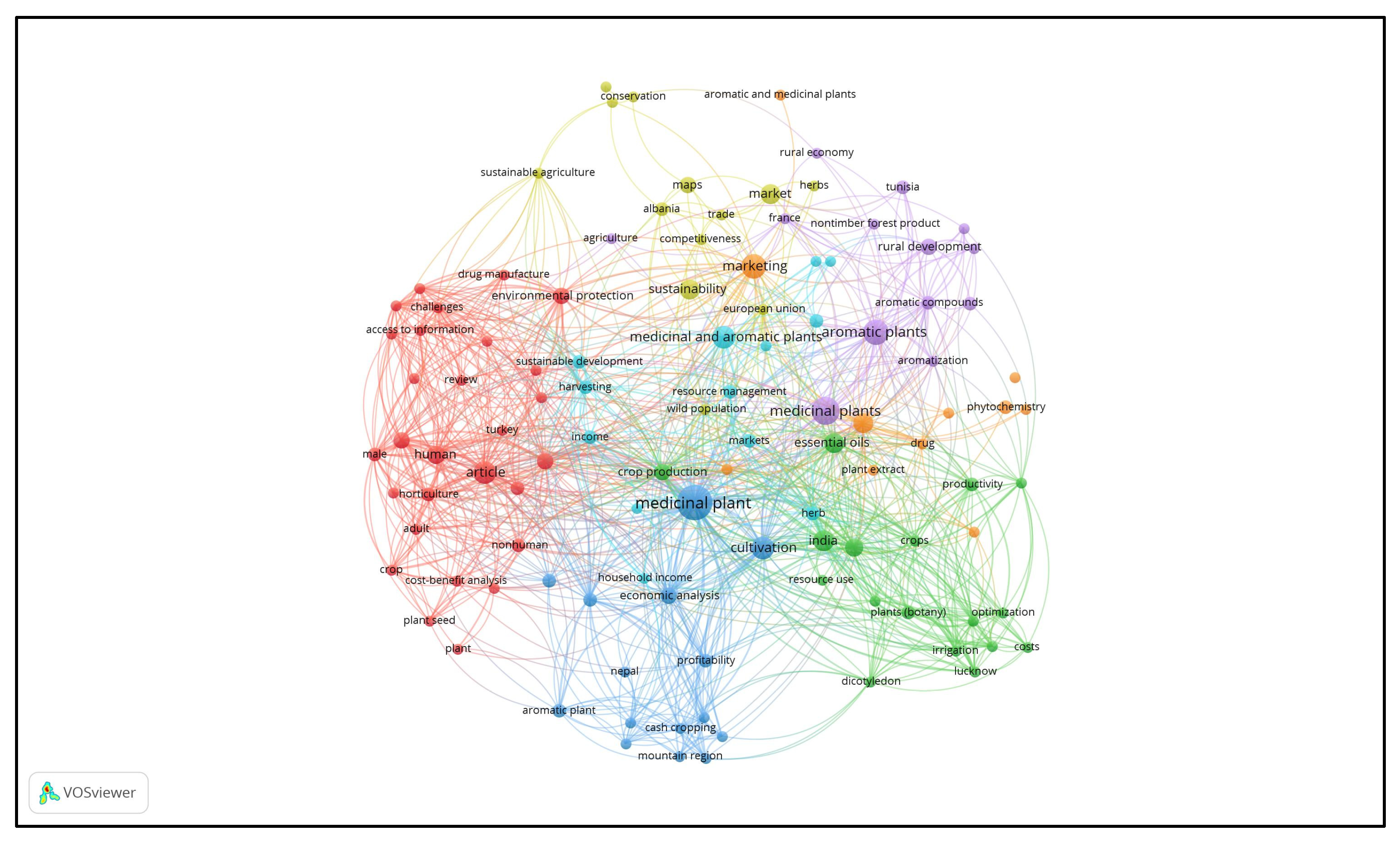

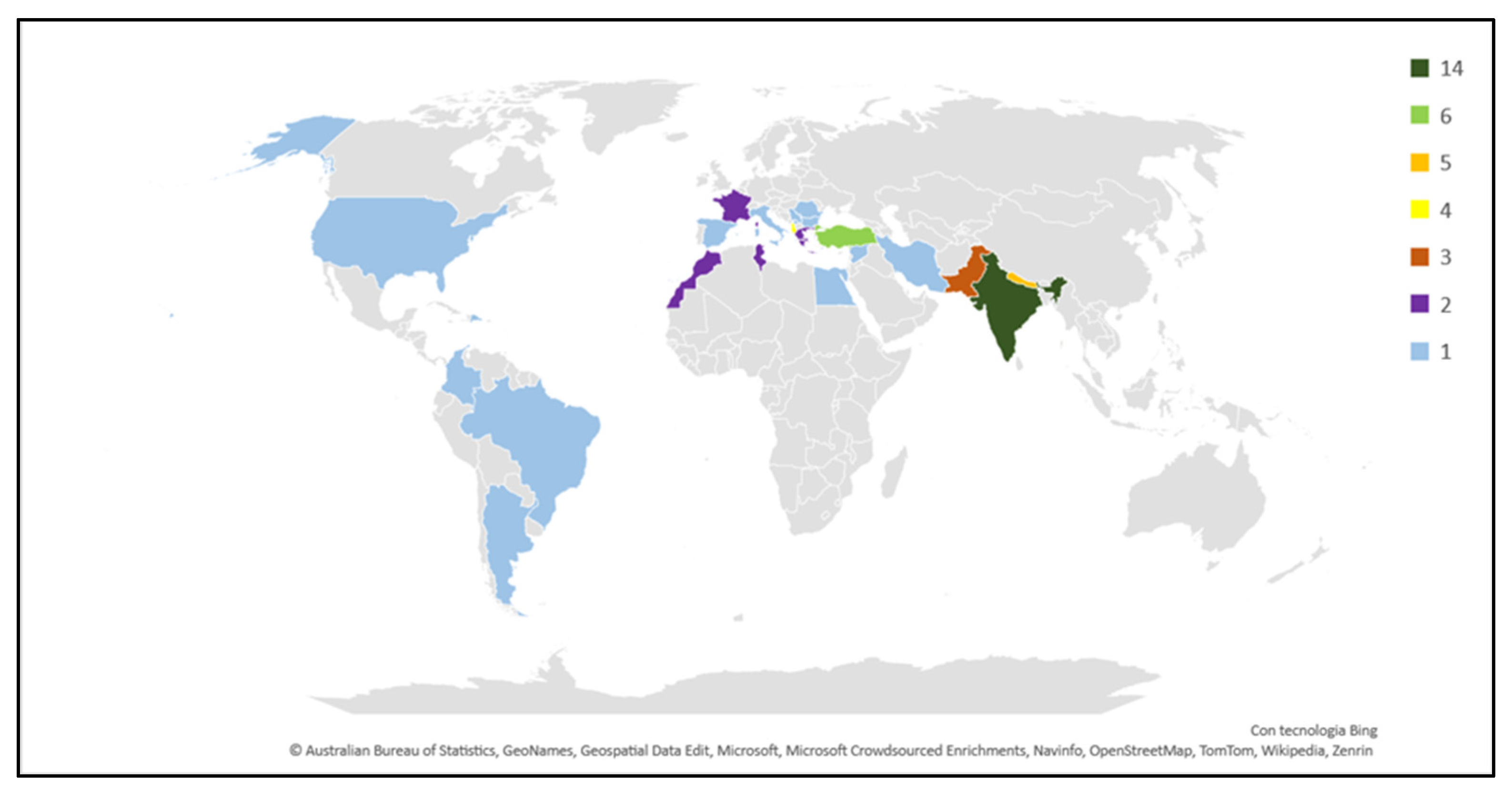
| Document Title | Year | Reference |
|---|---|---|
| (1) Planting of aromatic and medicinal plants in 1950 | 1950 | [55] |
| (2) Cultivation of medicinal and aromatic plants in 1950, in Czechoslovakia | 1950 | [56] |
| (3) Medicinal and aromatic plants from the pharmaceutic and industrial viewpoint | 1951 | [57] |
| (4) History of medicinal and aromatic plant culture with particular consideration of development in Germany | 1951 | [58] |
| (5) Value of variety selection in cultivation of medicinal and aromatic plants | 1952 | [59] |
| Source Title | N of Publications | % of Publications |
|---|---|---|
| Acta Horticulturae | 201 | 4% |
| Industrial Crops and Products | 149 | 3% |
| Journal Of Ethnopharmacology | 95 | 2% |
| Molecules | 75 | 1% |
| Journal Of Essential Oil-Bearing Plants | 63 | 1% |
| Journal Of Natural Products | 58 | 1% |
| Plants | 48 | 1% |
| Zeitschrift Fur Arznei Und Gewurzpflanzen | 48 | 1% |
| Journal of Applied Research on Medicinal and Aromatic Plants | 45 | 1% |
| Natural Product Communications | 45 | 1% |
| Total of the top ten contributor sources | 827 | 4% |
| N of manuscripts published in journals | 4683 | 88% |
| N of documents related to MAPs | 5318 | 100% |
| Manuscripts Title | N of Citations |
|---|---|
| Biological effects of essential oils—A review [61] | 5198 |
| Screening of radical scavenging activity of some medicinal and aromatic plant extracts [62] | 1515 |
| The antitumor activities of flavonoids [63] | 590 |
| The targets of curcumin [64] | 586 |
| Curcumin, demethoxycurcumin, bisdemethoxycurcumin, tetrahydrocurcumin and turmerones differentially regulate anti-inflammatory and anti-proliferative responses through a ROS-independent mechanism [65] | 536 |
| Solvent-free microwave extraction of essential oil from aromatic herbs: Comparison with conventional hydro-distillation [66] | 517 |
| Antimicrobial properties of plant essential oils against human pathogens and their mode of action: An updated review [67] | 490 |
| Correlation between chemical composition and antibacterial activity of essential oils of some aromatic medicinal plants growing in the Democratic Republic of Congo [68] | 468 |
| Composition and antimicrobial activity of essential oils from aromatic plants used in Brazil [69] | 419 |
| Clove (Syzygium aromaticum): A precious spice [70] | 399 |
| Research Area—MAPs in… | N of Manuscripts | Percentage |
|---|---|---|
| Ethnobotany | 56 | 12.7% |
| Essential oil | 51 | 11.5% |
| Agricultural aspects | 46 | 10.4% |
| Production, markets, trade, and value chain | 40 | 9.0% |
| Sustainable use, conservation, and valorization | 40 | 9.0% |
| Properties | 38 | 8.6% |
| Characterization, NMR fingerprints, pharmacognostic evaluation | 32 | 7.2% |
| Micropropagation and breeding | 25 | 5.7% |
| Rural economy | 21 | 4.8% |
| Biotechnology, DNA barcoding | 15 | 3.4% |
| Biofertilizers, biopesticides, and bioremediation | 9 | 2.0% |
| Product quality improvement | 9 | 2.0% |
| Industrial utilization | 8 | 1.8% |
| Technology aspects | 8 | 1.8% |
| Laws and certification | 8 | 1.8% |
| Drying | 7 | 1.6% |
| Bibliometric analysis | 6 | 1.4% |
| Food culture and functional food | 5 | 1.1% |
| Botanical characteristics | 4 | 0.9% |
| Impact assessment | 4 | 0.9% |
| Archaeobotanical investigation | 3 | 0.7% |
| Consumers’ attitudes | 3 | 0.7% |
| Use as substrate | 3 | 0.7% |
| Ecosystem services | 1 | 0.2% |
| Total | 442 | 100% |
| Structural Dimensions | Analytical Categories | N of Documents |
|---|---|---|
| Research methodologies/type of research | Modeling | 10 |
| Case studies | 12 | |
| Statistical data analysis | 17 | |
| Review | 9 | |
| Survey/interviews | 25 | |
| Level of analysis | Micro | 17 |
| Meso | 41 | |
| Macro | 15 | |
| Geographical focus | Specific geographical area | 64 |
| Not specific | 9 | |
| Research object | MAPs in general | 59 |
| Specific MAPs | 14 |
| Common Name | Scientific Name | References |
|---|---|---|
| Black rice | Oryza sativa L. indica | [83] |
| Wild apricot, soapnut, Nepalese pepper | Prunus davidiana, Sapindus mukorossi, Zanthoxylum armatum | [84] |
| Chamomile | Matricaria chamomilla | [85,86] |
| Catnip, stinging nettle, calendula, melissa, gray globemallow | Nepeta cataria L., Urtica dioica L., Calendula officinalis L., Melissa officinalis L., and Sphaeralcea incana Tort. | [87] |
| Artemisia, Asbos, lavender, rosemary | Artemisia afra, Pteronia incana, Lavandula officinalis, Rosmarinus officinalis | [88] |
| Coriander | Coriandrum sativum | [89] |
| Tejpat | Cinnamomum tamala Nees & Eberm | [90] |
| Callistemon | Callistemon viminalis | [91] |
| Indian mint | Plectranthus forskohlii Willd | [92] |
| Oregano | Origanum vulgare | [93] |
| Menthol mint | Mentha arvensis L. | [94] |
| Ginger | Zingiber officinale Rose | [95] |
| Aloe vera | Aloe barbadensis Miller | [96] |
| Thyme | Origanum Syriacum | [97] |
Disclaimer/Publisher’s Note: The statements, opinions and data contained in all publications are solely those of the individual author(s) and contributor(s) and not of MDPI and/or the editor(s). MDPI and/or the editor(s) disclaim responsibility for any injury to people or property resulting from any ideas, methods, instructions or products referred to in the content. |
© 2024 by the authors. Licensee MDPI, Basel, Switzerland. This article is an open access article distributed under the terms and conditions of the Creative Commons Attribution (CC BY) license (https://creativecommons.org/licenses/by/4.0/).
Share and Cite
Pergola, M.; De Falco, E.; Belliggiano, A.; Ievoli, C. The Most Relevant Socio-Economic Aspects of Medicinal and Aromatic Plants through a Literature Review. Agriculture 2024, 14, 405. https://doi.org/10.3390/agriculture14030405
Pergola M, De Falco E, Belliggiano A, Ievoli C. The Most Relevant Socio-Economic Aspects of Medicinal and Aromatic Plants through a Literature Review. Agriculture. 2024; 14(3):405. https://doi.org/10.3390/agriculture14030405
Chicago/Turabian StylePergola, Maria, Enrica De Falco, Angelo Belliggiano, and Corrado Ievoli. 2024. "The Most Relevant Socio-Economic Aspects of Medicinal and Aromatic Plants through a Literature Review" Agriculture 14, no. 3: 405. https://doi.org/10.3390/agriculture14030405
APA StylePergola, M., De Falco, E., Belliggiano, A., & Ievoli, C. (2024). The Most Relevant Socio-Economic Aspects of Medicinal and Aromatic Plants through a Literature Review. Agriculture, 14(3), 405. https://doi.org/10.3390/agriculture14030405









